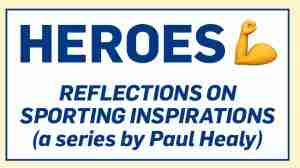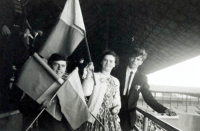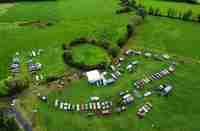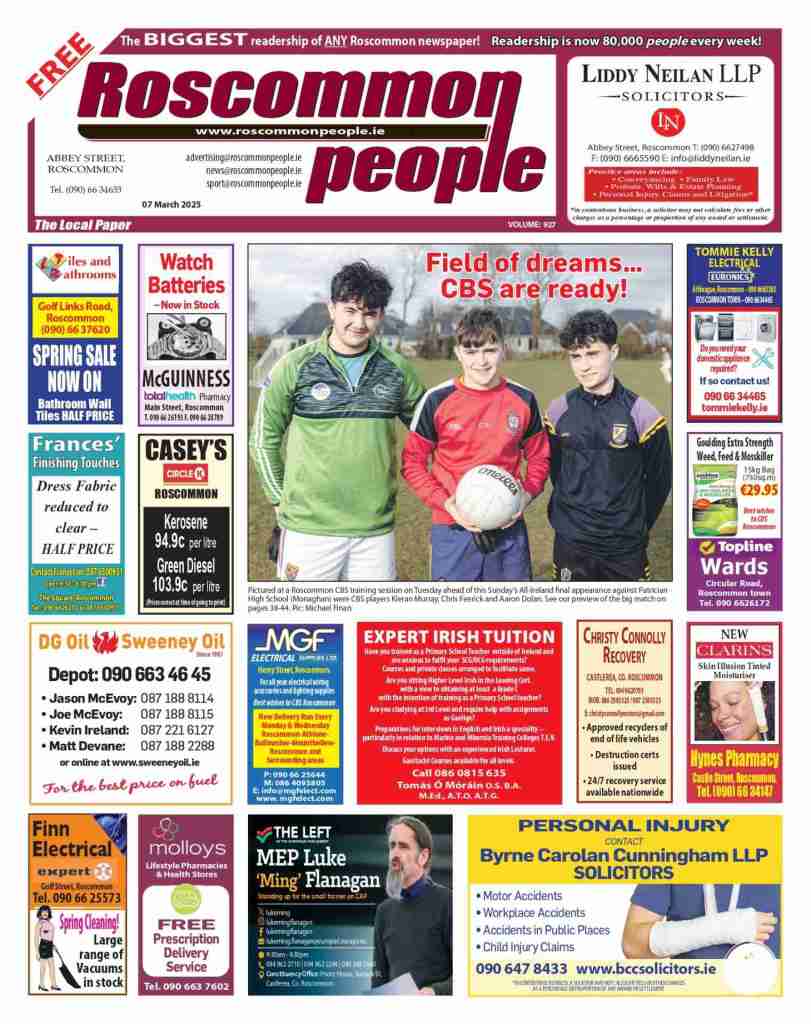 We always seemed to park on the beach in those days, as if the occasion was so momentous, so precious in all its promise, that it just had to be marked by our car being perched on the sand, equidistant between the rugged dunes and the gleaming sea. We weren’t the only ones. Most families seemed to park their Cortina or Hillman Hunter on the beach in those days.
We always seemed to park on the beach in those days, as if the occasion was so momentous, so precious in all its promise, that it just had to be marked by our car being perched on the sand, equidistant between the rugged dunes and the gleaming sea. We weren’t the only ones. Most families seemed to park their Cortina or Hillman Hunter on the beach in those days.
It was usually Sligo, except when it was Galway. On that summer’s day in 1982, it was Rosses Point. The sun was scorching. My father parked right bang in the middle of the sand. Around us, parents unfurled blankets and arranged picnic baskets and towels and buckets and spades, protectively marking their territory like they’d rented some new prime retail space on the High Street.
My father rolled the car window down, so we could hear Michael O’Hehir, wherever he was. The afternoon would be enjoyed to a soundtrack of kids giggling, shrieks of joy from the sea, and Michael’s voice. The sun, the beach, and the voice of the GAA.
As always, Michael made magic for our minds. But then RTE began to cut away from Michael. Time and time again they interrupted the King. So much so that we rose from the sand and hung on every word from the new voice coming from the car radio. And in the sweltering sun, with Michael for once silenced, we willed ever little white ball into every little hole. And sure enough, John O’Leary won the Carroll’s Irish Open, as children built castles in the sand on the beach in Rosses Point. An Irishman winning the Irish Open, in our time. A career high for O’Leary. A happy, glorious day in Rosses Point – and in Portmarnock. Later, we got back to Rooskey just in time to see the highlights. This golf…yeah, it could be interesting.
And not a schmozzle in sight.
From Florida to the fairway
Two years earlier, we were on a family holiday in Florida, a once-in-a-lifetime adventure. In Miami, I went into a small sports shop one day, where the tall, beaming youth behind the counter greeted me as if we’d always been friends. I asked if I could buy a ball “for soccer”, an enquiry which drew a blank expression from my new buddy. I repeated what I considered to be a reasonable request, particularly in a sports shop. It quickly became clear that my friend didn’t know the type of football I was referring to. “Soccer” I reiterated, “I want to play soccer”. He gestured for assistance, beckoning someone from the shop’s private quarters. Suddenly, his twin brother – equally tall and joy-filled – emerged from a side door. Then the first guy, who, I repeat, was running a sports shop, smiled at his brother: “Hey, you won’t believe it…this dude’s looking for a SOCCER ball!” (Now I could see the scale of the challenge facing George Best and Pele, in trying to help spread the Beautiful Game stateside).
Browsing in a bigger sports shop a few days later, I was admiring a set of golf clubs, just passing the time, when my father surprised me. Shocked me, in fact…by suddenly buying those beautiful new clubs for me! A thoughtful bonding gesture which I think cost him about 80 dollars, a nice ball of money 40 years ago. I’m not sure I made great use of them, but I’ll never forget that moment.
So, two years on, it’s 1982 and I’m finally making my golfing debut, teeing off at Longford Golf Club. I’ve come from Rooskey, my clubs have come all the way from Florida. How hard can this golf be? Swoosh! My first tee shot splits the fairway. Nice! Confident walk. And then the mental torture begins. Daisy-cutters. Slices. Fresh air shots. Lost balls. Underhit chips. Overhit chips. Divots. Despair. Mind muddled under the weight of advice from well-meaning friends. ‘Keep your head straight’. ‘Hold the club this way’. ‘Don’t try to murder the ball’. That sort of stuff. I stuck with it for 15 years, on and off. Consistent torture, punctuated by the odd inexplicably straight shot…
Getting hooked…
For all its cruelty, it’s easy to get hooked on golf. It’s a wonderful game. But, up to this point in my life at least, most of the enjoyment I’ve got from golf has been as a viewer, rather than as a player. And it’s been a great ride.
When I was becoming a fan, Ireland had its share of top class players. On their day, Darcy and O’Connor Junior, Rafferty and Walton, these guys could beat anyone, but they couldn’t quite reach the very top. My favourite Irish player of that era was Des Smyth, a magical putter in his prime.
With its abundance of superstars and characters, golf in the 1980s (and in later years) was perfect TV viewing for the sports fan. Bernhard Langer was the coolest guy around. Greg Norman was a swashbuckling superstar, who probably wrestled crocodiles as a pastime. Nick Faldo was Steve Davis with a golf club; merciless, apparently lacking charisma, ruthless, fascinating. The Americans – most of them dashing, flamboyant, supremely confident – brought the game to an exciting new level. I loved Jack Nicklaus, who was still having the odd great duel with fellow gentleman, Tom Watson. Lee Trevino wasn’t just a great golfer, he was also a pretty good amateur comedian! Arnold Palmer was past his best, but it was great to see the legend in action.
Even before Sky Sports, this was great fun and drama on our TV screens, whenever we were lucky enough to see golf. But for me, one man stood out. Occasionally he was the villain, mostly he was the hero. He was electrifying, capable of commanding all our attention, even on a stage occupied by people like Nicklaus and Norman. Yes, there was something about Seve…
Seve, the Matador
Seve was Severiano Ballesteros, a temperamental but enormously charismatic Spaniard, who was quite simply a golfing genius. He was an amazing shot-maker. He wasn’t as reliable on the conventional shots, something which made watching him all the more exciting!
The reason we loved Seve was because we had never seen anything like him before. Alex Higgins changed snooker through his personality and unique style; Ballesteros did much the same for golf. There were exciting players before him, but was there ever anyone as swashbuckling?
Seve was the most exciting golfer we’d ever seen. He played shots that we’d never seen before. His golfing peers hadn’t seen them either! His touch with a club was itself touched by genius. Fortunately for his fans, his tendency to lose his way on the golf course meant he frequently had to try and rescue himself with shots of outrageous skill and imagination.
I recall one Ballesteros birdie which summed up his appeal. Seve missed the fairway with his tee shot. His approach to the green then found a bunker. From the sand, he chipped into the hole. Rough to bunker to hole, a birdie that defied convention and logic! Throughout his career, there were many wonder shots that had fans (including his peers) gasping.
We loved Ballesteros for his thrilling play, and we also loved him for his passion. Great putts were greeted by his tradeback fist pump; tournament wins by his matador-like reaction.
His haul of five majors was fantastic, considering how unconventional a player he was. He was also World No. 1 for a period. And while injuries led to a drastic loss of form in the latter part of his career, the memory of his genius will live on forever.
The sands of time…
Now it’s 2020, and you’re not likely to see a Cortina or a Hillman Hunter on a beach in Sligo. And now John O’Leary is gone, having died in March of this year. And Michael O’Hehir is gone, and my father is gone too. The sands of time.
Every now and again, like most men, I clear out the garden shed. Or maybe I just rearrange the stuff. There’s stuff you throw out, and there’s stuff you should throw out, but don’t. I shuffle the half-empty fuel cans around, and stack the cans of paint in neat rows, as though their presence is part of some elaborate plan. Then I lift the golf bag and give the clubs a little shake, a chance to breathe. I lean the hopelessly outdated clubs against a different wall, or slide them on to another shelf. They’re pretty rusty now, as you can imagine, and certainly long out of fashion. But they’re still there…the golf clubs my father bought me in Florida in 1980.
I probably played with them 40 or 50 times, over 15 or 20 years, lots of dreadful shots, and a few of the satisfying ones that (theoretically) will always bring you back. They never let me down. It was always the other way around. Really, they deserved better; some bronzed, wisecracking American businessman should perhaps have tamed Florida’s finest courses with them. But they’re here, and they’re mine.
Some day, I might even take them out on the course for a final time, these clubs that hold such special memories for me…of Florida, of my attempts to learn this game, mostly of my Dad. Maybe they could swoosh one more time, swoosh back into time, like it’s 1980 all over again.
Seve is gone too. He died in 2011, only 54 years of age. He had battled illness and a chronic loss of form with typical courage. He was a wonderfully inspirational sportsman, a charismatic champion who thrilled millions of fans all over the world.
I have other golfing heroes from more recent times, and we may well return to them in this series. And when I think of those stars of the past, I fondly remember Jack Nicklaus, Greg Norman, Lee Trevino, and others. But Seve was special. A hero who inspired, and who was loved. The Matador with the unforgettable magic touch.






